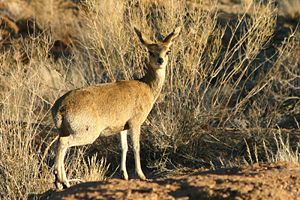Klipspringer
| Klipspringer | ||||||||||||
|---|---|---|---|---|---|---|---|---|---|---|---|---|

Female clip jumper |
||||||||||||
| Systematics | ||||||||||||
|
||||||||||||
| Scientific name of the tribe | ||||||||||||
| Oreotragini | ||||||||||||
| Pocock , 1910 | ||||||||||||
| Scientific name of the genus | ||||||||||||
| Oreotragus | ||||||||||||
| Smith , 1834 |
The Klipspringer ( Oreotragus ) are a small African antelope genus and at the same time a monotypical tribe. The name comes from Afrikaans - Dutch klipspringer means "rock diver ".
features
The klipspringer are among the most delicate representatives of the antelopes and reach a shoulder height of almost 60 cm and a body weight of 10–13 kg. The females are slightly larger and heavier than the males. The males also carry short, straight, widely spaced skewers, about 20-25 cm in length. In the northern populations, the females also have horns.
With their coarse, bristly, dense yellow to brown-gray fur, which has a black mottling and is white on the underside, they can hardly be seen in front of the "Kopjes" (boulders). The belly, chin and lips are covered with white or cream colored hair.
The klipspringer have two characteristics that are an adaptation to life in a rocky habitat. They are the only antelopes that walk on their hoof tips. These are processed in such a way that cylindrical hooves are created that leave a distinctive, two-circle trail. This specific shape of their hooves gives clippers a better grip on smooth rock surfaces. As a second adaptation, their fur is firm and thick. Every single hair is hollow and bristle-like. The fur offers good insulation against the temperature extremes of their high-altitude habitats. It insulates against both extreme heat and great cold.
distribution
This genus of antelope can be found from the South African Cape of Good Hope across East Africa to Ethiopia . It occurs among others in the following nature reserves: Bale Mountains National Park , Karoo , Mountain Zebra , Giant's Castle , Kruger Park , Namib-Naukluft , Hwange , Upemba , Tsavo , Lake Manyara , Ngorongoro , Serengeti , Kilimanjaro and Samburu .
Way of life
Klipspringers generally stay on or near rocky hills or rock formations. Often they can be seen motionless on the top of high cliffs. You can often hear the loud, nasal warning whistle of the animals. They are also very nimble in rough terrain. In the event of danger, they usually do not flee far, but stop after a short escape and watch the predator. The warning whistle can often be heard. However, this behavior also contributes to the fact that Klipspringer can be easily hunted down by humans.
You can find both couples and family groups; the males defend their territory. The couple relationships usually end only with the death of one of the two partners. The typical behavioral characteristics of the Klipspringer include the large piles of excrement, which are usually attached to the edge of the area. Females rub their pre-eye glands on nearby branches after defecating , which transfers a thick, black substance to the branches. These emit a strong sweet scent when wet. Usually the male puts his scent mark on that of the female. The klipspringer feed mainly on leaves.
The rutting season of the klipspringer lasts from September to January. The gestation period is 214 days. The single young weighs about 1 kg at birth. Their life expectancy is 10 to 12 years.
species
The tribe is structured as follows:
- Tribus Oreotragini Pocock , 1910
-
- Genus Oreotragus A. Smith , 1834
- Tanzanian Klipspringer ( Oreotragus aceratos Noack , 1899)
- Kenya Klipspringer ( Oreotragus aureus Heller , 1913)
- Zambia klipspringer ( Oreotragus centralis Hinton , 1921)
- Cape Klipspringer or Klipspringer ( Oreotragus oreotragus ( Zimmermann , 1783))
- Nigeria Klipspringer ( Oreotragus porteousi Lydekker , 1911)
- Ethiopian Klipspringer or Abyssinian Klipspringer ( Oreotragus saltatrixoides ( Temminck , 1853))
- Maasai Klipspringer or Schillings Klipspringer ( Oreotragus schillingsi Neumann , 1902)
- Somali klipspringer ( Oreotragus somalicus Neumann , 1902)
- Zimbabwean Klipspringer ( Oreotragus stevensoni Roberts , 1946)
- Angola Klipspringer ( Oreotragus tyleri Hinton , 1921)
- Transvaal klipspringer ( Oreotragus transvaalensis Roberts , 1917)
Man and Klipspringer
In various parts of Africa, cliff divers have always been hunted. A leather can be extracted from their skin, which is used to make bags. The meat should be very tasty. As a result of hunting, the klipspringer has almost become extinct in the West African part of its range (subspecies O. o. Porteousi ). In the rest of the distribution area it is not considered to be threatened.
Since some zoos stopped keeping the klipspringer in recent years, there are no European zoo populations with future prospects. At the moment three animals are kept in the zoological gardens in Frankfurt am Main and Valencia . Import efforts on the part of Frankfurt failed a few years ago. Since there are no offspring, it is to be expected that klipspringer will disappear from the European zoo landscape in the next few years. Since 1994 only Ethiopian klipspringer have been maintained in Europe .
supporting documents
literature
- Colin Groves and Peter Grubb: Ungulate Taxonomy. Johns Hopkins University Press, 2011, pp. 1–317 (SS 108–280)
- Colin P. Groves and David M. Leslie Jr .: Family Bovidae (Hollow-horned Ruminants). In: Don E. Wilson and Russell A. Mittermeier (eds.): Handbook of the Mammals of the World. Volume 2: Hooved Mammals. Lynx Edicions, Barcelona 2011, ISBN 978-84-96553-77-4 , pp. 444-779
- Gus Mills and Lex Hes: Mammals of Southern Africa. An illustrated encyclopedia. Könemann Verlag, Cologne 1997, ISBN 3-8290-3610-8
Web links
- Oreotragus oreotragus in the endangered Red List species the IUCN 2012. Posted by: Antelope Specialist Group, 2008. Accessed February 12, 2013.
Single receipts
- ↑ Mills et al., P. 264
- ↑ http://www.tiere-tierarten.de/tiere/klippspringer.shtml Profile of the Klippspringer



